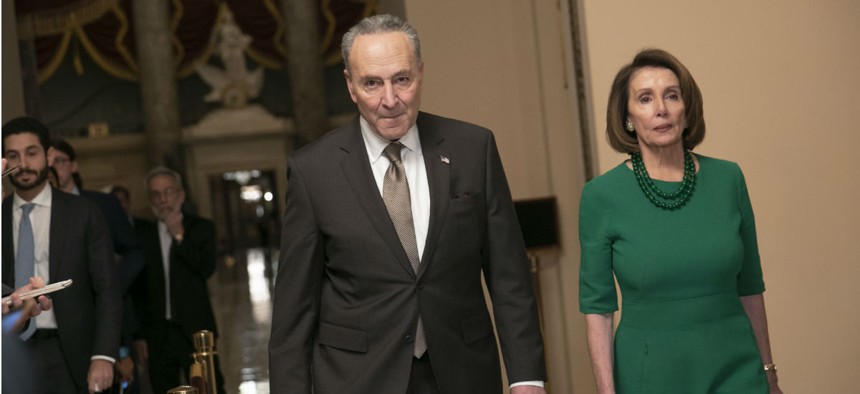
Senate Minority Leader Chuck Schumer, D-N.Y., (left) and House Speaker-designate Nancy Pelosi, D-Calif., said they have received mixed messages from different members of the Trump administration about the White House's demands. J. Scott Applewhite/AP
Democrats Announce Plan to Reopen Government, Including a Pay Raise for Feds
Republicans, White House not expected to go along with the proposal.
House Democrats have announced their opening bid to end the shutdown when they retake the majority on Thursday, stating their plan to pass a combination of six Senate appropriations bills to fund agencies that are closed as well as a continuing resolution for the Homeland Security Department.
With no breakthrough expected on Wednesday on the 115th Congress’ final day, the House on Thursday—the opening day of the 116th Congress—will vote on a consolidated package of bipartisan bills that came out of the Republican-controlled Senate Appropriations Committee to provide full fiscal 2019 funding for the departments of Transportation, Housing and Urban Development, State, Interior, Agriculture, Treasury, Commerce and Justice, as well as a number of independent agencies such as the Environmental Protection Agency, Office of Personnel Management and General Services Administration. It is also expected to pass stopgap funding through Dec. 8 for Homeland Security.
While the new Democratic majority can advance those measures without Republican support, Senate Majority Leader Mitch McConnell, R-Ky., is not expected to bring them up for a vote in the upper chamber. He has vowed not to cast any votes on spending bills until President Trump has given his blessing on a path forward.
The White House has already blasted the Democrats’ plan, saying it fails to provide funding for Trump’s proposed wall along the U.S.-Mexico border.
The proposal will “not re-open the government because it fails to secure the border and puts the needs of other countries above the needs of our own citizens,” White House Press Secretary Sarah Sanders said Tuesday evening. “The Pelosi plan is a non-starter because it does not fund our homeland security or keep American families safe from human trafficking, drugs, and crime.”
A continuing resolution at Homeland Security would continue the fiscal 2018 appropriation level of $1.3 billion for new border security measures. Trump has requested $5 billion specifically for wall funding, but has reportedly lowered that figure to $2.5 billion. Sanders said that Trump “made a serious, good faith offer to Democrats to open the government” but Democrats refused to compromise.
For their part, Senate Minority Leader Chuck Schumer, D-N.Y., and House Speaker-designate Nancy Pelosi, D-Calif., said they have received mixed messages from different members of the Trump administration about the White House's demands.
“The president wanted the shutdown, but he seems not to know how to get himself out of it,” they said in a joint statement last week. “As long as the president is guided by the House Freedom Caucus, it’s hard to see how he can come up with a solution that can pass both the House and Senate and end his Trump Shutdown.”
Schumer and Pelosi, as well as Republican congressional leaders, will head to the White House on Wednesday to meet with Trump. Sanders described the meeting as a “border security briefing from senior Department of Homeland Security officials.”
More than 340,000 federal employees are currently on furlough without a guarantee of back pay, while an additional 500,000 are working but facing delayed paychecks.
On Friday, Trump issued an executive order finalizing his proposal to freeze federal employees’ pay in 2019. The consolidated package of spending bills the House plans to pass on Thursday, however, would override that order and provide civilian workers with a 1.9 percent pay bump. Senate negotiators agreed to that figure in 2018, but it never came up for a vote on the floor. Several Senate Democrats wrote a letter to Trump on Monday asking him to reverse course on the freeze, and vowing to otherwise work “on a bipartisan basis” to ensure a raise occurs legislatively.
House Democrats also announced their package of rules to govern the chamber during the 116th Congress. It includes the elimination of the Holman Rule, which allowed lawmakers to zero-out salaries for individual employees and funding for specific programs.
Sign up for GovExec newsletters and alerts and download our app to stay informed.







